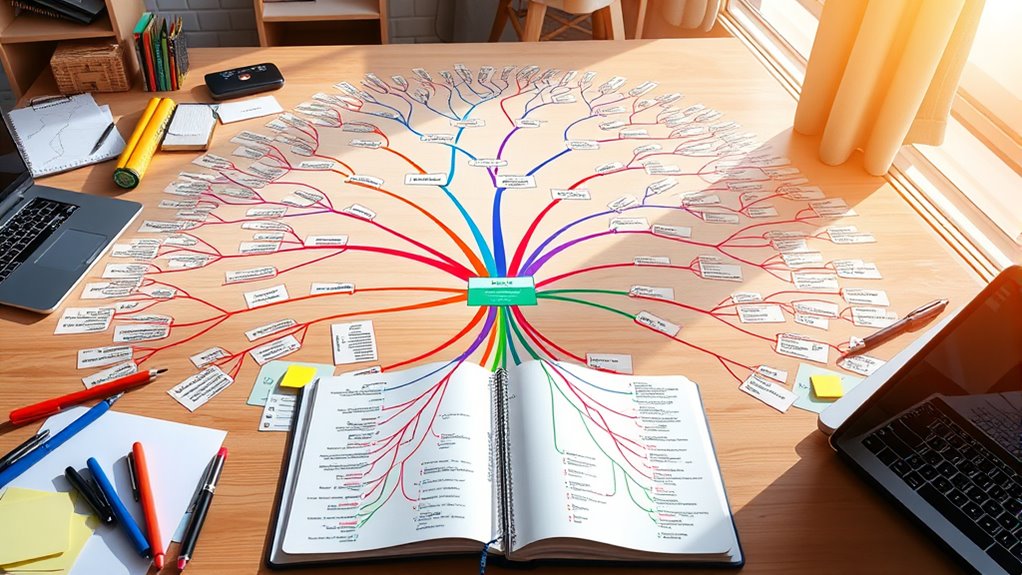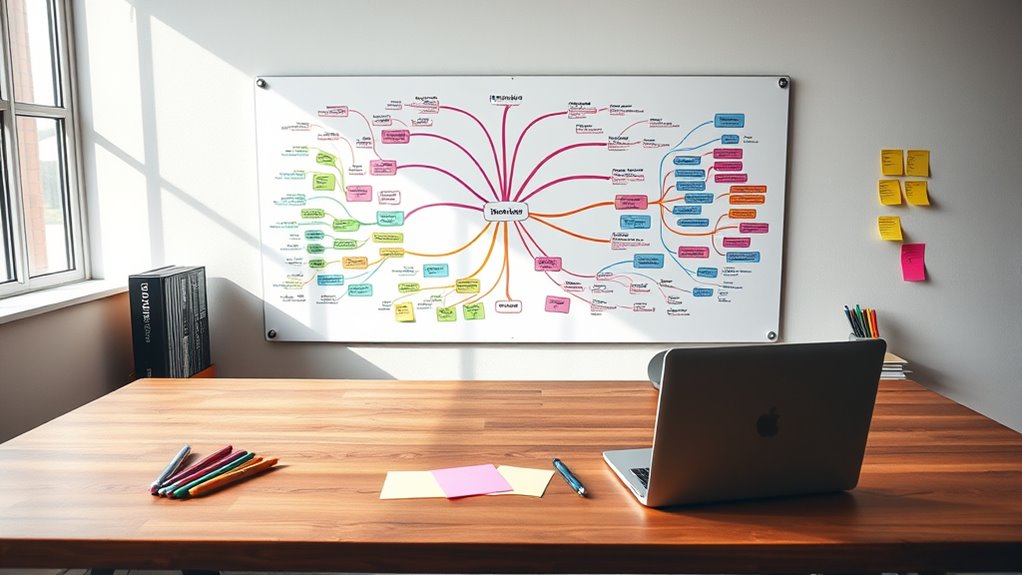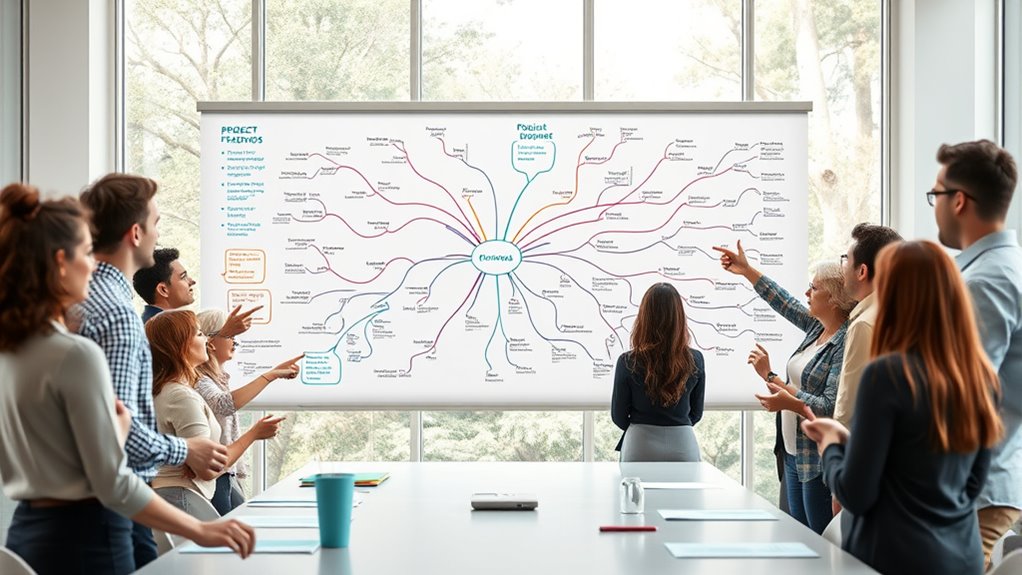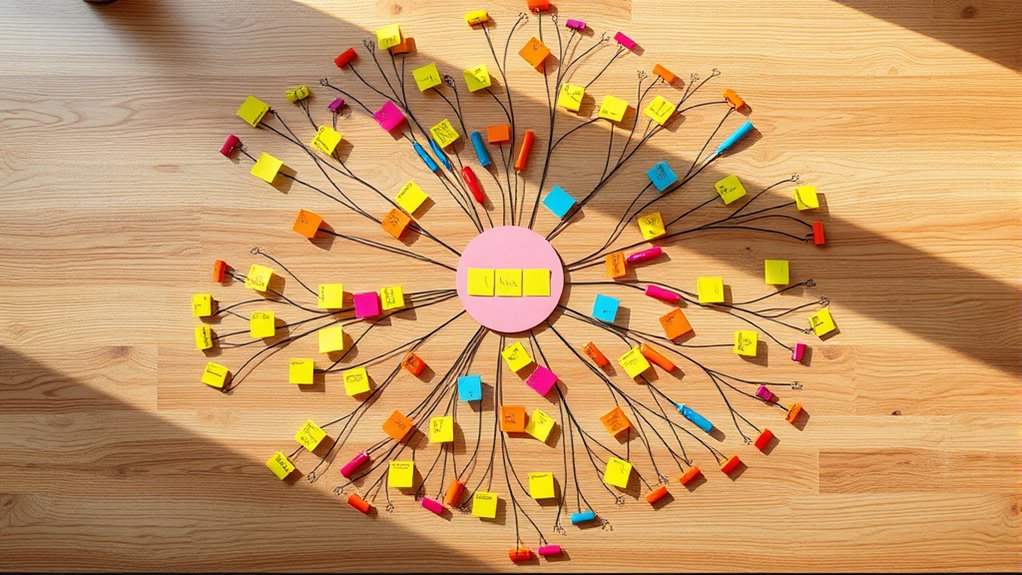Using mind mapping helps you organize complex projects visually, making ideas, tasks, and dependencies clearer. It allows you to break down goals into manageable steps, highlight relationships, and identify potential bottlenecks easily. You can customize layouts, add visuals, and collaborate in real-time, ensuring everyone stays aligned. This dynamic approach simplifies intricate details and keeps your project on track—continue exploring for more tips to master effective mind mapping.
Key Takeaways
- Visualize all project components, including tasks, resources, and deadlines, for comprehensive clarity.
- Break down complex projects into manageable subtopics and map their relationships to identify dependencies.
- Use color schemes, icons, and layouts to emphasize key ideas and improve information organization.
- Collaborate in real-time with team members to update and refine the project map dynamically.
- Monitor progress and milestones visually to ensure alignment and facilitate decision-making.
Understanding the Basics of Mind Mapping

Mind mapping is a visual tool that helps you organize and connect ideas quickly and effectively. It boosts your creative brainstorming by allowing you to see relationships between concepts at a glance. As you create a mind map, you engage in active thinking, which enhances your memory and recall of important details. This technique encourages a free flow of ideas, making it easier to identify connections you might overlook with traditional note-taking. You start with a central concept and branch out into related themes, keywords, or tasks. By visually structuring information, you make complex projects more manageable. Mind mapping not only sparks creativity but also improves your ability to remember key points, making it a valuable tool for tackling challenging projects efficiently. Additionally, understanding the relationship between ideas can help you better apply this technique to complex projects.
Identifying Key Components of Your Project

Once you’ve laid out the basic structure of your project through a mind map, the next step is to pinpoint its key components. Use brainstorming techniques to generate ideas about what elements are essential, such as resources, deadlines, and deliverables. Conduct stakeholder analysis to identify who is involved and how their needs influence the project’s core parts. Focus on the main objectives, critical tasks, and key decision points. These components form the backbone of your project, guiding your planning and execution. By clearly identifying these elements, you ensure your project stays focused and manageable. Keep refining your mind map as new insights emerge, and always consider stakeholder input to capture all crucial aspects. Additionally, understanding the unique and wicked planters available can help tailor project goals for specific environments or themes.
Breaking Down Tasks and Subtasks Visually

How can you effectively manage complex projects? The key is breaking down tasks and subtasks visually using a mind map. This approach helps you see the full scope of your project and organize tasks logically. As you add tasks, focus on task prioritization, identifying which are urgent or essential. Then, break each task into subtasks, using subtask visualization to clarify steps and dependencies. This makes it easier to assign responsibilities and track progress. Visualizing subtasks allows you to spot overlaps or gaps, ensuring nothing slips through the cracks. By mapping tasks and subtasks clearly, you create a roadmap that simplifies complex projects and keeps you focused on what’s most important at each stage.
Mapping Relationships and Dependencies

After breaking down tasks and subtasks visually, the next step is to map out how these elements relate and depend on each other. This is where dependency mapping comes into play. You’ll create a clear visualization of relationships between tasks, showing which activities rely on others for completion. Relationship visualization helps you see potential bottlenecks and overlaps, making project flow more transparent. By mapping dependencies, you identify critical paths and understand the sequence of actions needed to move forward efficiently. This process clarifies priority areas, reduces confusion, and helps you anticipate delays. Using your mind map, you can easily spot how changes in one task impact others, enabling better planning and resource allocation throughout your project. Understanding Gold IRA rollover processes can also help you streamline investment transitions and avoid common pitfalls.
Enhancing Collaboration Through Visual Planning

You can improve team collaboration by visualizing tasks clearly within your mind maps, making responsibilities and deadlines easy to understand. Sharing interactive maps allows everyone to stay updated and contribute their insights in real-time. By streamlining communication flow through visual planning, you reduce misunderstandings and keep the project moving smoothly. Incorporating traditional techniques and materials into your maps can also enrich the cultural context and foster a deeper appreciation among team members.
Visualize Team Tasks
Have you ever struggled to see how individual tasks fit into a larger project? Visualizing team tasks with a mind map makes this clear. By mapping out each task and showing their relationships, you improve team task delegation. Everyone understands their responsibilities and how their work contributes to the overall goal. Workload visualization helps you spot bottlenecks or uneven distribution early, so you can reassign tasks efficiently. This visual approach streamlines communication, reduces confusion, and keeps everyone aligned. You can see at a glance which parts are progressing and where support might be needed. Using a mind map to visualize team tasks transforms complex projects into manageable, interconnected components, enhancing collaboration and ensuring everyone stays on the same page throughout the process. Incorporating visual planning tools further boosts clarity and team cohesion.
Share Interactive Maps
Sharing interactive maps takes visual planning a step further by enabling teams to collaborate in real-time. With interactive map sharing, everyone can view and update the project simultaneously, ensuring clarity and transparency. This approach fosters immediate feedback and helps identify potential issues early. When you share interactive maps, your team can easily track progress and see visual project updates, making complex information more digestible. It also encourages active participation, as team members can add comments, suggest adjustments, or highlight priorities directly on the map. By facilitating seamless collaboration, interactive map sharing keeps everyone aligned and informed, reducing misunderstandings and streamlining decision-making. Embracing this method transforms static plans into dynamic, collaborative tools that enhance your project management process. Incorporating performance metrics can further help monitor engagement and improve overall effectiveness.
Streamline Communication Flow
How can visual planning tools enhance communication flow within a team? Mind maps clarify complex projects by creating clear feedback loops and promoting stakeholder alignment. They serve as a central hub for sharing updates, reducing miscommunication, and ensuring everyone stays on the same page. Visuals simplify how information is conveyed, speeding up decision-making and problem-solving. Use the following table to see how visual planning improves communication:
| Aspect | Benefit | Example |
|---|---|---|
| Feedback loops | Immediate clarification | Real-time updates |
| Stakeholder alignment | Clear expectations | Shared project goals |
| Visual clarity | Reduces confusion | Simplified task breakdown |
| Collaboration | Boosts team synergy | Interactive brainstorming |
Additionally, knowing the hours of operation for various restaurants can facilitate scheduling meetings or planning team outings effectively.
Using Digital Tools for Dynamic Mind Maps

Digital tools make creating dynamic mind maps easier by offering real-time collaboration features that keep everyone on the same page. You can customize visual templates to suit your project’s needs, making your maps more intuitive. Plus, with cloud accessibility, you can access and update your mind maps from anywhere, anytime. Incorporating visual organization techniques can further enhance clarity and understanding in complex projects.
Real-Time Collaboration Features
Real-time collaboration features in digital mind mapping tools enable teams to work together seamlessly, regardless of their physical locations. With real-time editing, everyone can make changes simultaneously, keeping the map current and synchronized. This instant feedback allows team members to share ideas, ask questions, and refine concepts on the fly, reducing delays and misunderstandings. You can see updates as they happen, which fosters a dynamic, interactive environment. These features encourage active participation and streamline decision-making, making complex projects easier to manage. By leveraging real-time collaboration, you guarantee that all team members stay aligned, contributing their insights instantly. Additionally, predictive analytics can be integrated to anticipate project needs and optimize workflows, further enhancing productivity and helping you clarify complex ideas more efficiently.
Customizable Visual Templates
Customizable visual templates empower you to tailor mind maps to fit your project’s specific needs, making complex information more accessible and engaging. With customizable templates, you can choose layouts, color schemes, and icons that align with your workflow, enhancing clarity. Visual design becomes a tool for emphasizing key ideas and organizing details effectively. These templates allow you to create consistent visuals across your project, making it easier to interpret and share information. By adjusting elements like node styles and backgrounds, you ensure your mind map communicates precisely what you intend. This flexibility keeps your project dynamic and personalized, helping you stay focused and motivated. Using digital tools with customizable visual templates transforms static maps into engaging, easy-to-understand representations of complex projects. Understanding how to withdraw from your retirement plan can also help you manage your funds more effectively as your needs evolve.
Cloud Accessibility Options
Have you ever needed to access your mind maps from different locations or devices? Cloud accessibility options make this simple, allowing you to work seamlessly across platforms. By utilizing cloud storage, your mind maps are stored securely online, ensuring you can access them anytime, anywhere. Many digital mind mapping tools meet accessibility standards, making them usable for everyone, including those with disabilities. With real-time syncing, updates you make on one device instantly appear on others, keeping your project data current. This flexibility enhances collaboration and keeps your workflow smooth. Cloud-based options also ensure your files are backed up automatically, reducing the risk of data loss. Overall, cloud accessibility options empower you to manage complex projects efficiently, without being tied down to a single device or location.
Applying Mind Maps for Ongoing Project Management

Applying mind maps to ongoing project management transforms how you monitor progress and handle changes. They serve as dynamic tools for maintaining clarity amid evolving tasks. To maximize their effectiveness, focus on:
- Using mind maps for creative brainstorming, generating new ideas quickly and visually.
- Engaging stakeholders by sharing updates and gathering feedback directly within the map.
- Tracking milestones and deadlines, ensuring everyone stays aligned and aware of project status.
- Incorporating data-driven marketing strategies to analyze project performance and make informed decisions.
Frequently Asked Questions
How Can Mind Mapping Improve Stakeholder Communication?
You might wonder how to boost stakeholder communication. Mind mapping offers visual clarity, making complex ideas easier to understand. It engages stakeholders by involving them in the process, encouraging their input and feedback. As a result, communication becomes clearer and more effective. By using mind maps, you create a shared visual tool that fosters stakeholder engagement, ensuring everyone stays aligned and informed throughout the project.
What Are Common Pitfalls When Creating a Mind Map?
When creating a mind map, you should watch out for common pitfalls like visual clutter, which makes it hard to interpret, and oversimplification, which can omit critical details. You might be tempted to add too many branches or keep it too sparse, so strike a balance. Focus on clarity and relevance, ensuring your map communicates effectively without overwhelming or under-informing. This way, your mind map remains a useful tool.
How Often Should a Project Mind Map Be Updated?
Imagine your project’s roadmap as a living tree, constantly growing and changing. You should update your mind map regularly, ideally following a consistent revision schedule—perhaps weekly or biweekly—so it stays accurate and useful. The timing frequency depends on your project’s pace; faster projects need more frequent updates. Keep your map fresh, and it’ll guide you smoothly through evolving challenges and new opportunities.
Can Mind Maps Replace Traditional Project Management Tools?
You might wonder if mind maps can replace traditional project management tools. While mind maps excel at providing a visual hierarchy and fostering creative brainstorming, they often lack features for task tracking and resource management. So, you shouldn’t see them as replacements but as complementary tools. Use mind maps to clarify ideas and structure projects visually, while sticking to traditional tools for detailed planning, scheduling, and progress monitoring.
What Skills Are Necessary to Create Effective Mind Maps?
Creating effective mind maps is like planting seeds for clarity. You need strong visualization techniques to organize ideas clearly, making complex information easier to grasp. Brainstorming strategies help you generate fresh, relevant connections. Skills in identifying key concepts, categorizing details, and maintaining focus are essential. Practice regularly to sharpen your ability to visually map out projects, ensuring your mind maps become powerful tools for understanding and communication.
Conclusion
By mastering mind mapping, you turn chaos into clarity, like shining a light through a tangled web. It helps you see the big picture and break down complex projects into manageable parts. With visual tools and strategic planning, you’ll navigate obstacles smoothly and keep everyone on the same page. Think of mind maps as your project’s GPS—guiding you steadily toward success with every step.









